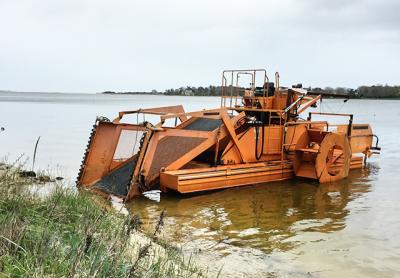Good News for Georgica Pond

The removal of more than 55,000 pounds of macroalgae from Georgica Pond last summer is likely responsible for a substantial reduction this year in levels of toxic blue-green algae, and should be repeated next year, the East Hampton Town Trustees were told on Monday.
Sara Davison, executive director of the Friends of Georgica Pond Foundation, summarized a report stating that the pond, which the trustees have closed to the harvesting of crabs and other marine life for much of the last three summers, had some of the lowest levels of the toxic algae, also known as cyanobacteria, measured on Long Island this year. At the same time, dissolved oxygen in the pond remained at safe levels, and there was no observation of fish or other wildlife kills.
The mechanical harvester operated between May and September. The 55,740 pounds of organic material, which releases nutrients that are believed to contribute to cyanobacteria blooms, represented up to 10 percent of the pond’s nitrogen load for July and August and 20 percent of the phosphorus load for the same period, according to the report, which was prepared by Christopher Gobler of Stony Brook University’s School of Marine and Atmospheric Sciences. Dr. Gobler has been monitoring water quality for the trustees for several years and more recently was retained by the foundation, a group of pondfront property owners. The harvested material was taken by truck to the town’s recycling center for composting.
“Dr. Gobler is a conservative scientist, and he feels that more data is needed,” Ms. Davison told the trustees. “But when you remove that much nitrogen and especially that much phosphorus, he thinks that it could have had an impact on the lower blue-green algae blooms. We’re heartened by the result of the first year of data, and we’d like to come to you to do it again one more year and see what it does.” Ms. Davison said that a smaller harvester would be used next year to allow operation in straits and very shallow water. The State Department of Environmental Conservation would have to issue a new permit, and the town would have to reauthorize use of a motorized craft on the pond.
“It’s only one year’s data,” said Bill Taylor, a trustee, “but it’s very good data. . . . There’s other factors that could be in there, but this is worth pursuing.”
Ms. Davison asked that the buoy that transmitted temperature, salinity, algae, and other data be returned to the pond next year, and relayed additional remediation proposals from Dr. Gobler. These include sampling and analyzing sediment from the pond to determine if it is releasing nutrients, which would aid in identifying areas where dredging would be most effective, and a study and inventory of the fish and crabs in the pond. Colleagues of Dr. Gobler at Stony Brook would perform both, she said. Ms. Davison also proposed testing for fecal bacteria, and said that Dr. Gobler can identify its source. Testing for fecal matter from humans, geese, birds, deer, and dogs would help to determine nutrient loading from surface water runoff versus septic systems, for example, she said.
Another priority for 2017, Ms. Davison said, “is to work with homeowners in the immediate watershed to upgrade their septic systems.” Preliminary reaction has been “very positive,” she said. Lastly, the foundation is set to install a permeable reactive barrier, a vertical trench placed near the shoreline that intercepts nitrogen groundwater, and is working to identify a site for a second barrier.
